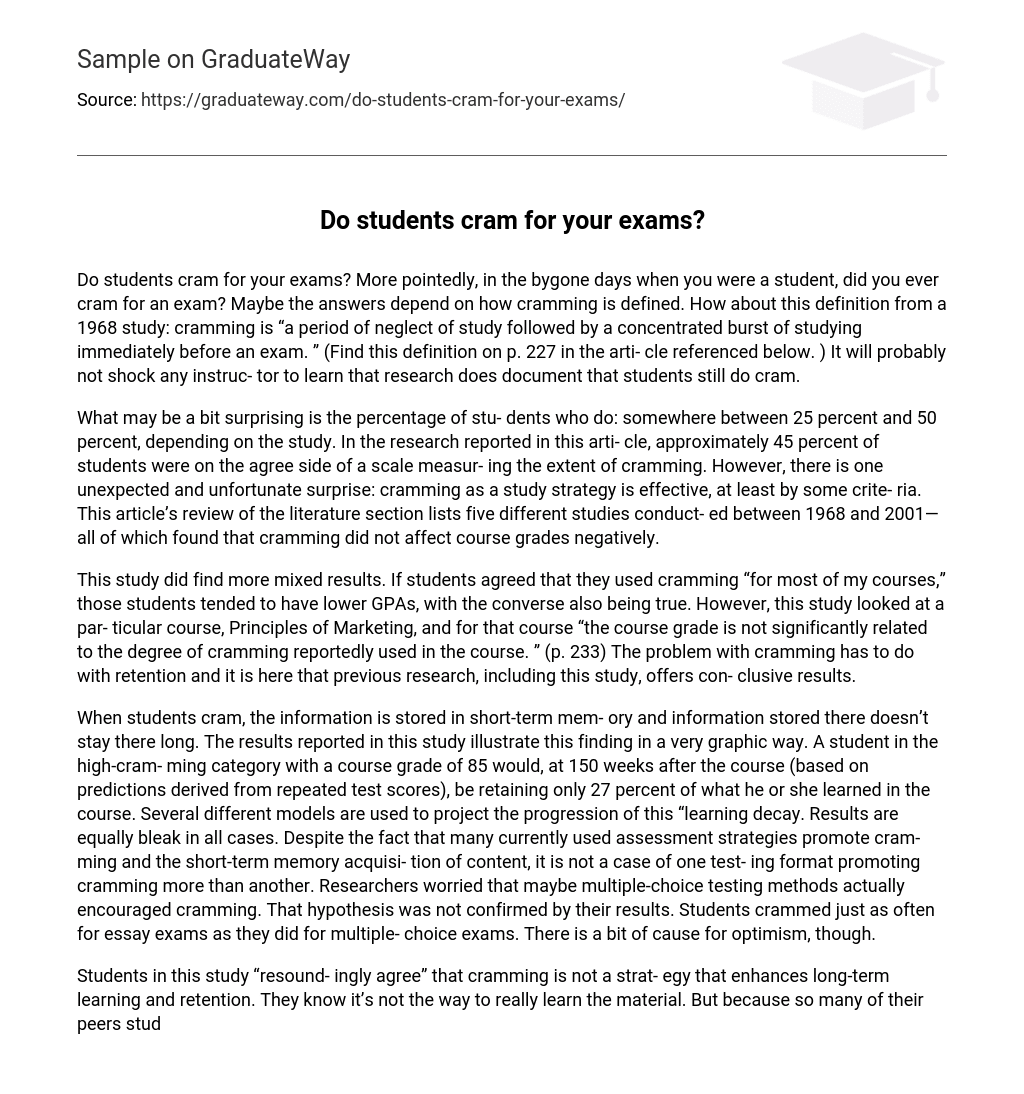The definition of cramming may vary. In a study mentioned in the article (page 227) from 1968, cramming is defined as “a period of neglect of study followed by a concentrated burst of studying immediately before an exam.” It is not surprising that research indicates students continue to cram for exams.
Surprisingly, a significant percentage of students, ranging from 25 to 50 percent, engage in exam cramming. In this particular study discussed here, around 45 percent of students confessed to cramming. However, there is an unexpected downside: some standards view cramming as an effective technique. The literature review section of this article investigates five studies conducted from 1968 to 2001, all of which found that cramming did not negatively affect grades.
According to the study, students who heavily relied on cramming for their courses had lower GPAs compared to those who did not rely on cramming. However, when it came to Principles of Marketing, the amount of cramming reported by students did not have a significant impact on their course grade. The issue with relying on cramming is that it affects retention negatively, which has been shown in previous research as well as this study.
When students cram, the information is stored briefly in short-term memory and is quickly forgotten. The results from this study vividly demonstrate this phenomenon. Based on the study, if a student crams and achieves a course grade of 85, they will only retain 27 percent of what they learned after 150 weeks. This prediction is derived from repeated test scores, and various models are employed to forecast the decline in learning over time.
Regardless of the scenario, the results are equally disappointing. While many assessment strategies advocate for cramming and short-term memorization, no testing format specifically encourages it more than another. There was concern among some researchers that multiple-choice tests might actually promote cramming, but their findings did not confirm this theory. Students crammed at the same rate for essay exams as they did for multiple-choice exams. However, there is a small ray of hope.
The study reveals that students recognize cramming as an ineffective strategy for long-term learning and retention, despite its prevalence due to peer pressure, procrastination habits, and busy schedules. This article provides valuable insights on the topic and includes a 49-question tool to assess students’ involvement in cramming and their views on its efficacy.
In addition to including mean responses for individual items, administering an instrument like this to students can be equally revealing for both the instructor and the students. If there is not enough time to administer the entire survey, sharing some of the responses to individual items can generate a lively discussion about this study strategy. The researchers have developed three different definitions for cramming, which distinguish the degrees of cramming that students reportedly engage in. Additionally, this research article includes a section of thoughtful and helpful recommendations.
Regularly advocated recommendations in this newsletter include teaching students the distinctions between deep and surface learning and designing instruction to prioritize and reward deep learning. Assessment offers some of the most fascinating and innovative recommendations. It is evident that tests focusing on short-term recall encourage cramming as a successful study strategy. In addition to utilizing various types of tests, researchers are considering the potential of delayed retaking exams, which would be viable only in the context of a major.
After finishing a course, students may retake the final exam, which keeps the course grades uncertain until these retest scores are factored in. A more practical proposal is for students to take course prerequisites right before the actual course. By reducing the gap between courses, students would maintain a better grasp of their learnings and reinforce their knowledge from the first course more immediately in the second one. The recommendation section disapproves of teachers’ teaching methods.
The use of PowerPoint slide lectures and handouts does not encourage students to take their own notes, leading to hindered comprehension and last-minute cramming. In other words, both the format of tests and the presentation of information in class can discourage cramming and affect learning.
Reference
- McIntyre, S. H. and Munson, J. M. (2008). Exploring Cramming: Student Behaviors, Beliefs, and Learning Retention in the Principles of Marketing Course.” Journal of Marketing 30(3): 226-243.





